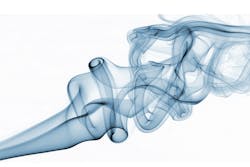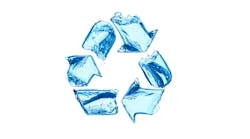Professor POU/POE: Condensing water vapor from air for drinking and bulk water
Q: Are products that condense water vapor from air a viable means of producing drinking water and bulk water?
A: They can work. Whether they are cost effective depends upon the available alternatives.
It is well-known that ambient air contains humidity, water vapor. The amount of water vapor in the air is a function of the location, season and time of day and is measured as relative humidity. Vaporized water is a gas, so it physically exists in air as other gases with respect to temperature and partial pressure. The U.S. Department of Energy says that on a hot, humid day water vapor could comprise as much as 6 percent of the air; on a cold day it could be 0.07 percent. At an average relative humidity of 64 percent in the Negev desert, about 11.5 milliliters (ml) of water could be present in a cubic meter of air.
Relative humidity is the ratio of the partial pressure of water vapor at a given temperature to the equilibrium vapor pressure at that temperature. It is usually expressed as a percentage; a higher percentage means that the air-water mixture is more humid. Air can reach approximately 100 percent relative humidity during continuous rainfall, in fog and in the early morning. Humidity in the air affects the body’s ability to evaporate perspiration, so higher humidity causes us to feel warmer and the air to seem sticky.
The dew point is the temperature at which water will theoretically condense from the air at saturation. Morning dew forms from water that has condensed onto surfaces because the air temperature has dropped to the point where it is approaching saturation and cooler surfaces such as leaves provide condensation sites. Dew points of less than about 65ºF are comfortable.
Portable or fixed devices that can extract water from air in remote, dry locations have application potential in disasters, war zones and deserts. About 20 percent of the earth is considered desert. Some can reach 50ºC (more than 122ºF) or higher during daylight, but they can also sometimes drop below freezing at night. Deserts usually reach high temperatures and have low humidity, but cold deserts exist that average up to 10 inches of rain per year. Semiarid deserts see perhaps 1 inch of rain annually. Evaporation exceeds rainfall, so rain might never reach the ground in some arid, hot cases. In the Mojave Desert in the western U.S., the average daytime humidity can be as low as 10 percent, and nighttime humidity can be as high as 50 percent.
What is in the air besides water vapor?
Air contains mostly nitrogen, oxygen, carbon dioxide and some water vapor, plus a variety of other components such as suspended particulates (dust), bacteria and viruses. Traces of other gases such as methane, nitrogen oxides and volatile emissions from combustion processes, and even from painted surfaces, carpets and furniture may be present. These can vary by location and whether the environment is indoor or outdoor. A process that condenses water from air will also entrain some of the contaminants in the concentrate, so it is necessary to clean the water that has been condensed before it can be consumed as drinking water. The principal contaminants of concern are usually the microbial components, some of which could be pathogens. Therefore, the post-condensation treatment technology should include some type of disinfectant as well as filters to remove particulates and dissolved chemicals. Several providers use ultraviolet (UV) light disinfection in addition to granular carbon or other types of filters for other contaminants.
How do air to water processes work?
The concept is not new and follows well-known laws of chemistry and physics. Evidence of fog and dew collection systems on cool surfaces has been found in ancient civilizations in the Middle East and South America. The National Aeronautic and Space Administration uses atmospheric condensation in space stations, and it has contracted for a system (WAVAR) to condense water from the Martian atmosphere in a future Mars landing. The atmosphere would be cycled through a zeolite resin to accumulate water from its release point by microwave heat, then collected.
Essentially two types of air to water machines exist: those that operate by condensation of water vapor on a lower temperature surface and those that use a concentrated brine solution to absorb the vapor followed by evaporation of water from the brine. Fundamentally, condensation systems are like dehumidifiers, which are refrigeration systems that collect water from the air. For example, basements are cooler and more humid than upper rooms, so many homes use dehumidifiers to reduce the humidity levels. Condensation becomes less efficient below about 65ºF and 30 percent relative humidity, but it is still possible. System efficiency improves with higher relative humidity, especially approaching 80 to 90 percent.
A fairly standard air to water system would consist of a particulate filter for incoming air, evaporator/condenser, collection tank, purification system including cartridges and disinfection (UV), storage tank, cold storage tank and tap. The water would be aggressive to metal surfaces and require stabilization. Costs would include the components plus electricity, operation, maintenance and pumping. Electricity consumption costs are a function of the efficiency of the system and power cost, but some systems can be solar -powered with associated solar collection system and conversion costs. One complex system claims to utilize thermal solar collectors and photovoltaic cells to make the process energy autonomous. It utilizes a hygroscopic brine to absorb moisture as it runs down a tower-shaped unit before it collects in a tank under vacuum. Solar heat causes evaporation of water from the brine solution, which condenses and runs downward, producing the vacuum (apparently as a Venturi) so that a vacuum pump is not required.
When water is condensed, heat is removed, so the cooling system must provide sufficient energy removal that would be equivalent to the amount of energy required to vaporize the water. The heats of vaporization or condensation of water are 40.65 kilojoules (kJ) per mole (40,650 joules per 18 grams; 2,258,000 joules per kilogram). One joule is equivalent to 0.24 gram calories (2.78 x 10-7 kilowatt-hours; 9.47 x 10-4 BTU). The energy cost would be electricity consumption of the refrigeration and fan units in the condensation and cooling processes, modified by the overall energy efficiency of the system.
Costs
Compared to other bulk water sources, the cost of condensed air systems is usually greater. Piped tap water in Washington, D.C., costs about $5 per thousand gallons or about 0.5 cents per gallon, which is probably above the national average. Bottled drinking water sells at retail from about $1 to $5 or more per gallon, depending on the package size and purchase location.
Several commercial air to water systems have been available in world markets for many years. Some are advertised as novel ways of providing water in water-scarce areas. Military applications are an obvious market, and the U.S. and other countries have contracted for the development for portable water generators to support troops in the field in dry environments. They have also developed personal and truck-mounted portable water treatment systems for other field operations. At least one, somewhat extreme, do-it-yourself approach has been advertised as a survival essential for individuals to become independent of external water sources, in turn insulating them from the coming world water crisis and the societal upheaval they envision.
Some manufactures claim to be able to produce water in large quantities for 20-year amortized costs in the range of 10 to 20 cents per gallon, which is equivalent to $100 to $200 per thousand gallons. Some have even suggested producing irrigation water from air. Military applications are undoubtedly more concerned with performance, reliability, ruggedness, mobility and production quantity rather than costs.
Standards
Since these are potential drinking water generators, it would be appropriate for an American National Standards Institute/National Sanitation Foundation (ANSI/NSF) standard to be produced. NSF International initiated a process to develop an ANSI/NSF standard for air to water products, but it has been suspended. Some existing ANSI/NSF standards, such as 42 (aesthetics), 53 (treatment units health effects), 55 (UV light systems), 60 (additives) and 61 (extractables), could apply to some of the components.
If there were an application for providing water for a community in the U.S. exceeding 25 persons or 15 connections, federal and state requirements would apply. State requirements would probably be applicable for fewer than 25 people or 15 connections and some might require independent certification for individual home systems.
Conclusion
Over the years, numerous systems for extracting water from air have been developed. Some are passive natural systems for dew and humidity collection, some are small scale to produce a few liters and others are large enough to produce thousands of gallons per day. The devices are usually condenser systems much like a dehumidifier, and some utilize a brine solution to absorb the water vapor so that it can be evaporated and condensed in a later step. Water obtained from air must undergo additional treatment to be considered safe to drink. Amortized costs of 10 to 20 cents per gallon, equivalent to $100 to $200 per thousand gallons, are certainly much higher than typical tap water, but necessity is the mother of invention and willingness to pay is a function of need. If sufficient, life-sustaining water is not available in a location, then any cost could be acceptable, and alternatives including water recycling, desalination and bottled or bulk water shipments are alternatives to compare. Some manufacturers utilize solar thermal and photovoltaic power to operate their systems, so they should be independent of electrical power sources, assuming there is adequate and sustained sunlight.
We can conclude that there are potential applications where water from air can be successful for a price. There is probably a need for more information on actual life cycle costs and reliability for specific products in particular environments before decisions among alternative sources of water can be made with confidence.
Dr. Joe Cotruvo is president of Joseph Cotruvo and Associates, LLC, Water, Environment and Public Health Consultants. He is a former director of the EPA Drinking Water Standards Division.


